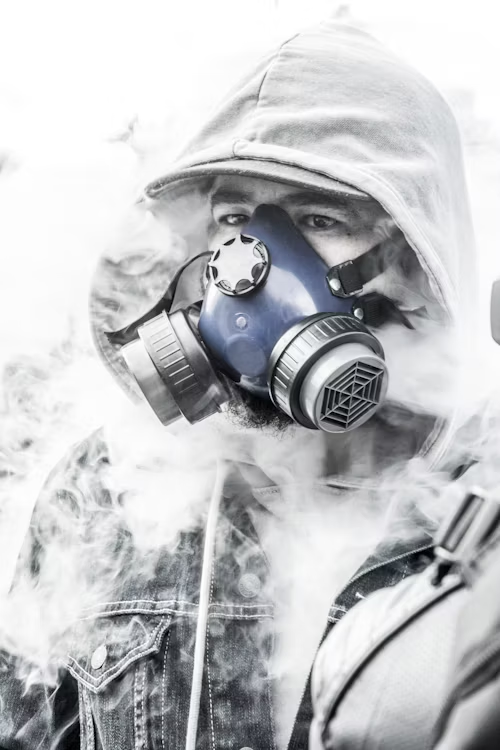Lifestyle
Asbestlint: Health Risks and Safety Precautions

Asbestlint—a term that might not be familiar to everyone, but its implications are significant. This seemingly innocuous material has a complicated history rooted in industrial applications and health hazards. While it was once hailed for its durability and insulation properties, the dark side of asbestlint reveals serious risks to human health. Understanding what asbestlint is, how it affects our bodies, and the safety measures necessary when handling it is crucial for anyone involved in construction or renovation projects. Let’s delve into this topic to better understand both the dangers associated with asbestlint and how we can protect ourselves from potential harm.
What is Asbestlint?
Asbestlint, commonly known as asbestos tape, is a flexible material made from woven asbestos fibers. It has been primarily used for insulation and sealing purposes in various industrial applications. Its resistance to heat and chemicals made it a popular choice for HVAC systems, pipes, and electrical components.
The unique properties of asbestlint allowed it to be an effective barrier against high temperatures and moisture. However, the very qualities that made it useful also posed significant health risks when disturbed or damaged.
Once widely employed in construction projects throughout the 20th century, its use has sharply declined due to growing awareness of the dangers associated with asbestos exposure. Today, many regulations restrict or ban its usage entirely across different countries. Understanding what asbestlint is lays the groundwork for recognizing why safety precautions are essential when dealing with this hazardous material.
How Does Asbestlint Affect Health?
Asbestlint poses significant health risks when inhaled. This material releases tiny fibers into the air, which can easily be absorbed by the lungs. Over time, these fibers lead to serious respiratory diseases.
One of the most alarming conditions associated with asbestlint exposure is mesothelioma. This aggressive cancer primarily affects the lining of the lungs and chest cavity. Symptoms often take years to appear, making early detection challenging.
In addition to cancer, prolonged exposure can result in asbestosis—a chronic lung disease that causes scarring and stiffness in lung tissue. Individuals may experience shortness of breath and a persistent cough as their condition worsens.
Furthermore, even minimal contact with asbestlint can trigger asthma attacks or other allergic reactions in sensitive individuals. The cumulative effects highlight a pressing need for awareness regarding its dangers and preventive measures against exposure.
Common Uses of Asbestlint
Asbestlint, or asbestos tape, has been widely utilized for its insulation properties. It is often found in older buildings as a sealing material around pipes and ducts. The durable nature of asbestlint makes it effective at preventing heat loss.
Another common application includes soundproofing. Many industrial facilities used it to reduce noise levels in machinery rooms. This made work environments more comfortable for employees.
Additionally, asbestlint was popular in fireproofing applications. Its resistance to high temperatures allowed it to protect critical structures from fire hazards.
Despite its usefulness, the health risks associated with asbestos have led to significant regulations surrounding its use today. Awareness of these applications is crucial when dealing with older construction materials that may still contain this hazardous substance.
Safety Precautions When Dealing with Asbestlint
When working with asbestlint, safety is paramount. Always wear appropriate personal protective equipment (PPE), including a high-efficiency particulate air (HEPA) filter mask, gloves, and disposable coveralls. This minimizes the risk of inhaling harmful fibers.
Ensure that the workspace is well-ventilated. Open windows or use exhaust fans to reduce airborne particles. If possible, cordon off the area to limit access.
Use wet methods when handling asbestlint to suppress dust. Spraying water can help contain asbestos fibers and prevent them from becoming airborne during removal tasks.
Keep all tools dedicated solely for asbestos work to avoid cross-contamination. Clean up thoroughly after completing any task involving asbestlint; dispose of waste in sealed bags designed for hazardous materials.
Always follow local regulations regarding disposal methods and never attempt DIY removal if you lack proper training or certification. Safety should always come first when dealing with this dangerous material.
Removal and Disposal of Asbestlint
Removing and disposing of asbestlint is a task that must be handled with extreme caution. Due to the hazardous nature of asbestos, it’s critical to follow strict protocols.
First, ensure you wear proper personal protective equipment (PPE), including respirators, gloves, and coveralls. This minimizes exposure to harmful fibers during the process.
Next, seal off the work area using plastic sheeting. This helps contain any dust or debris created while handling asbestlint.
When removing it from surfaces, dampen the material slightly to prevent airborne particles. Always use hand tools instead of power tools; this reduces the risk of fiber release.
Dispose of all waste in accordance with local regulations. Asbestos should be placed in clearly labeled containers designed for hazardous materials before being transported to designated disposal sites.
Health Risks for Professionals Working with Asbestlint
Professionals working with asbestlint face significant health risks due to prolonged exposure. The fibers released during handling can enter the lungs, leading to severe respiratory issues.
Asbestlint is notorious for causing diseases such as asbestosis and lung cancer. These conditions develop over years of exposure, making early detection challenging. Symptoms may not appear until decades later.
Additionally, workers in construction or demolition are particularly vulnerable. They often encounter damaged materials that release asbestos particles into the air. Without proper protective gear, inhalation becomes a serious risk.
Regular monitoring and health screenings are essential for professionals dealing with asbestlint regularly. This proactive approach helps identify any potential health issues before they become severe.
Understanding these risks reinforces the need for stringent safety measures in workplaces exposed to asbestos-related materials.
The Importance of Proper Training and Certification
Proper training and certification are crucial when working with asbestlint. Knowledge of its properties, risks, and safe handling techniques dramatically reduces health hazards.
Workers need to understand the types of asbestos fibers present in materials. Each type poses different risks and requires specific methods for safe removal or repair.
Certification ensures that individuals possess the necessary skills to navigate hazardous situations effectively. It empowers them with knowledge about federal regulations and safety protocols. This understanding is vital for compliance and protects both workers and occupants from exposure.
Moreover, ongoing education keeps professionals updated on industry advancements. New technologies or methods can significantly improve safety standards over time.
Investing in training shows a commitment to workplace safety culture, fostering trust among employees, clients, and regulatory agencies alike. In high-risk environments like those involving asbestlint, proper certification isn’t just beneficial; it’s essential for safeguarding public health.
Conclusion
Asbestlint poses significant health risks due to its potential for releasing harmful asbestos fibers into the air. Understanding what asbestlint is and how it can affect your health is vital for anyone who may come in contact with it. Its common applications, especially in older buildings, make awareness even more essential.
When handling asbestlint, following safety precautions can minimize exposure. Proper removal and disposal are crucial steps that require professional expertise to ensure safety standards are met. It’s important not only for individual safety but also to protect others who might be affected by improper management of this hazardous material.
For professionals working with asbestlint, the stakes are higher. The risk of developing serious health issues necessitates rigorous training and certification programs tailored specifically for dealing with asbestos products safely. Staying informed and educated on these matters can lead to safer work environments.
Understanding these aspects creates a foundation for responsible handling of materials like asbestlint while prioritizing health and safety at all times.

Lifestyle
sinp city: Museums, Art Galleries, and Historic Sites

Las Vegas, often dubbed “sinp city,” is a place that conjures images of neon lights, extravagant casinos, and endless nightlife. Yet beneath the surface of this vibrant entertainment hub lies a rich tapestry of culture waiting to be explored. Many visitors flock here for the thrill of gambling or exhilarating shows, but what if we told you there’s so much more? Beyond the glitz and glamour are museums brimming with history, art galleries showcasing local talent, and historic sites that tell the story of this iconic city. Ready to discover another side of Sin City? Let’s embark on an adventure through its cultural treasures!
What is sinp city?
Sin City is a captivating nickname for Las Vegas, a vibrant oasis in the Nevada desert. Known primarily for its nightlife, casinos, and entertainment options, this dazzling city has so much more to offer.
At first glance, it might seem like just another party destination. However, beneath its glitzy facade lies a rich tapestry of culture and history waiting to be explored.
Visitors often flock to iconic resorts and endless shows. Yet there’s an undercurrent of artistic expression that runs deep here.
From world-class museums showcasing art and science to historic sites that tell tales of resilience and innovation—Sin City invites exploration beyond the neon lights. It’s a place where creativity thrives amid the chaos. Each corner holds stories waiting to unfold; each visit reveals something new about this extraordinary urban landscape.
History of Museums, Art Galleries, and Historic Sites in Las Vegas
Las Vegas, often dubbed Sin City, has a rich tapestry of cultural history that goes beyond its glitzy casinos. The evolution of museums and art galleries here reflects the city’s transformation from a dusty desert outpost to a vibrant metropolis.
The Nevada State Museum showcases artifacts that highlight the region’s Native American heritage and mining history. Established in 1990, it serves as an educational hub for both locals and tourists alike.
Art galleries began flourishing in the late 20th century. This growth was driven by artists seeking refuge from more traditional scenes elsewhere. Today, places like the Bellagio Gallery of Fine Art feature acclaimed exhibitions that draw art lovers year-round.
Historic sites tell stories too; hidden gems like the Neon Boneyard preserve iconic signs from Las Vegas’ past. Each location contributes layers to Sin City’s multifaceted identity, celebrating creativity amidst its renowned entertainment scene.
Top Museums to Visit in Las Vegas
Las Vegas is not only about bright lights and flashy casinos. The city boasts an impressive lineup of museums that cater to diverse interests.
The Neon Museum stands out with its collection of iconic Las Vegas signs. Each piece tells a story, illuminating the evolution of this vibrant city.
For those intrigued by the darker side of history, the Mob Museum provides a gripping look at organized crime’s impact on America. Interactive exhibits keep visitors engaged and informed.
Art enthusiasts should not miss the Bellagio Gallery of Fine Art. It features rotating exhibitions from world-renowned artists, blending culture with luxury.
For science lovers, the Discovery Children’s Museum offers hands-on experiences that inspire curiosity in all ages. This museum emphasizes learning through play while showcasing engaging exhibits across various subjects.
Must-See Art Galleries in Sin City
When exploring Sin City, the vibrant art scene beckons. Start your journey at the Bellagio Gallery of Fine Art. This intimate space showcases rotating exhibitions from renowned artists around the globe.
Next, visit The Neon Museum. Here, history merges with creativity as you wander among restored neon signs that narrate Las Vegas’s evolution. It’s a feast for both eyes and imagination.
For contemporary flair, head to 18b Arts District. This eclectic neighborhood is dotted with artist studios and pop-up galleries displaying innovative works by local talent.
Don’t overlook the Las Vegas Natural History Museum either. While primarily focused on nature, it features fascinating art installations that bridge science and aesthetics beautifully.
Each gallery tells a story uniquely tied to Sin City’s culture, offering visitors an enriching experience beyond its famed nightlife.
Hidden Gems: Historic Sites You Won’t Want to Miss
Las Vegas is not all glitz and glamour. Tucked away from the neon lights are historic sites waiting to be discovered. One such gem is The Neon Boneyard, where vintage signs tell stories of yesteryear. Each piece captures a slice of Las Vegas history.
Another must-see is the Old Las Vegas Mormon Fort State Historic Park. This site offers a glimpse into the city’s origins, showcasing its early settlers and their remarkable journey in an arid landscape.
The Clark County Museum also deserves attention. Here, you can explore artifacts that trace local history from prehistoric times through modern-day developments.
Don’t overlook the Springs Preserve either. With gardens and exhibits highlighting native plants and wildlife, it’s perfect for those who appreciate nature alongside history. These hidden gems add depth to sinp city vibrant culture, proving there’s more than meets the eye in this dynamic destination.
How these Cultural Attractions Add Diversity to the City’s Reputation
Las Vegas, often labeled as sinp city, boasts a rich tapestry of cultural attractions that enhance its reputation. Beyond neon lights and casinos, these sites reveal the city’s multifaceted identity.
Museums like The Neon Museum celebrate the history of Las Vegas through vibrant signage. This blend of art and nostalgia invites visitors to appreciate the city’s evolution over decades.
Art galleries spotlight local talents, showcasing everything from contemporary works to traditional pieces. They foster creativity and dialogue among diverse communities.
Historic sites tell stories of resilience and transformation. Locations such as the Old Las Vegas Mormon Fort offer glimpses into the early days before glitz took over.
Together, these elements create a unique cultural landscape that enriches Sin City’s allure. Visitors leave with more than just memories; they carry an appreciation for art, history, and community spirit found within this dynamic environment.
Conclusion: Why Las Vegas is More Than Just a Party Destination
Las Vegas, often dubbed “sinp city,” is widely recognized for its vibrant nightlife and entertainment. However, the heart of this desert oasis beats to a more diverse rhythm than many realize. The city’s rich tapestry includes an impressive array of museums, art galleries, and historic sites that showcase not only its storied past but also its commitment to culture and creativity.
Visitors can immerse themselves in unique exhibitions at renowned institutions like the Neon Museum or explore contemporary masterpieces in local galleries. Each cultural venue offers a glimpse into the evolving narrative of Las Vegas beyond glitz and glamour.
The hidden gems scattered throughout Sin City reveal stories from different eras – remnants of old casinos turned historical landmarks or neighborhoods steeped in history waiting to be explored. These attractions provide depth to the city’s character, enriching every visitor’s experience.
Las Vegas isn’t just about late-night escapades; it’s a destination where art thrives amid dazzling lights. The blend of entertainment with cultural exploration transforms it into a multifaceted haven for adventurers seeking more than just parties. For those willing to venture off the beaten path, Sin City’s artistic side is boundless and captivating.
Embracing both modernity and tradition allows visitors to appreciate what makes Las Vegas truly special—a place where creativity flourishes against an iconic backdrop that continues to evolve while honoring its roots.
Lifestyle
hürrilet: The Essence of Freedom in Modern Society

In a world that constantly evolves, the concept of freedom remains at the heart of our aspirations. Enter “hürrilet,” a term that encapsulates this essence in modern society. But what does it truly mean? As we navigate through complex social landscapes and political climates, understanding hürrilet becomes essential for grasping how we can foster genuine liberty in our lives. Join us on this journey as we explore its profound significance and uncover ways to weave hürrilet into the fabric of everyday existence. Freedom isn’t just an ideal; it’s a practice, and together, we’ll discover how to embrace it fully.
What is hürrilet?
Hürrilet is a Turkish term that embodies the concept of freedom. It transcends mere political liberty, reaching into personal autonomy and social justice.
At its core, hürrilet signifies the right to express oneself without fear. This includes thoughts, beliefs, and actions. In many ways, it represents the heartbeat of a progressive society.
The essence of hürrilet also intertwines with cultural identity. It encourages individuals to embrace their heritage while advocating for universal rights.
In modern times, this notion has sparked movements aimed at dismantling oppression worldwide. The pursuit of hürrilet inspires collective action across various communities.
It challenges norms and pushes back against restrictions imposed by authority figures or societal expectations. As such, it stands as a powerful reminder that freedom is not merely an individual quest but a shared responsibility among all citizens.
The Evolution of Freedom in Society
Freedom has transformed significantly throughout history. From the ancient philosophers who first pondered its nature to modern thinkers, our understanding of freedom has expanded.
In early societies, freedom often meant mere survival and autonomy from oppressive rulers. As communities grew, so did the complexity of rights and individual liberties. The Enlightenment introduced new ideas about personal freedoms and social contracts.
Fast forward to today, where technology reshapes how we perceive freedom. Digital landscapes offer unprecedented access but also come with challenges related to privacy and surveillance.
Social movements have emerged as powerful forces advocating for various forms of liberty—be it racial equality or gender rights. Each wave builds upon past struggles while redefining what it means to be free in a global context.
As society evolves, so does the concept of hürrilet—allowing us to explore deeper dimensions of autonomy that resonate across diverse cultures and experiences.
The Impact of hürrilet on Modern Society
Hürrilet has reshaped the landscape of modern society in profound ways. It offers a lens through which we can examine our freedoms and responsibilities.
In an age where information flows freely, hürrilet encourages individuals to think critically about their choices. Social media platforms have become avenues for expressing this newfound liberty. People share ideas and challenge norms like never before.
Moreover, hürrilet fuels innovation and creativity. Entrepreneurs thrive in environments that value freedom of thought. This leads to groundbreaking solutions addressing societal challenges.
At the same time, it reminds us of the collective responsibility that comes with freedom. As voices grow louder, so does the need for empathy and understanding among diverse perspectives.
Challenges arise as well when balancing personal liberties with communal needs. Yet, navigating these complexities is essential for fostering a vibrant society grounded in true freedom.
Examples of hürrilet in Action: Social Movements and Political Changes
Hürrilet manifests vividly in various social movements and political changes around the globe. One striking example is the Arab Spring, where citizens united to demand democratic reforms. Fueled by a desire for personal freedoms, people took to the streets, challenging oppressive regimes.
In recent years, climate activism has also showcased hürrilet’s essence. Groups like Fridays for Future mobilize youth worldwide to advocate for sustainable practices and environmental justice. Their energy reflects a collective yearning for freedom from ecological degradation.
Another significant instance can be seen in movements advocating for racial equality. The Black Lives Matter movement has brought attention to systemic injustices while empowering individuals to voice their demands for change.
Each of these examples highlights how hürrilet drives passion and unity among diverse communities striving toward a more equitable society. It embodies the undying quest for autonomy and dignity that resonates across cultures.
How to Incorporate hürrilet into Your Daily Life
Incorporating hürrilet into your daily life starts with awareness. Take a moment each day to reflect on what freedom means to you. This could involve journaling or simply meditating on your thoughts.
Next, engage in conversations that challenge conventional ideas. Discussing diverse perspectives can open new pathways of understanding and inspire action.
Consider volunteering for causes that resonate with you. Being active in your community fosters connections and promotes the values of hürrilet through tangible efforts.
Embrace creativity as an expression of freedom. Whether through art, writing, or music, let your imagination flow without boundaries.
Practice self-care by setting personal boundaries. Clearly defining what is acceptable helps maintain emotional well-being and reinforces autonomy in everyday choices. Each small step taken contributes to a richer experience of freedom in life’s journey.
The Benefits and Challenges of Living with hürrilet
Living with hürrilet opens the door to numerous benefits. It fosters a sense of individuality and encourages self-expression. People are empowered to pursue their passions without fear, leading to innovative ideas and diverse perspectives.
However, embracing this freedom isn’t without challenges. The responsibility that comes with autonomy can feel overwhelming at times. Choices must be made carefully, as they shape one’s path and impact others.
Moreover, in a society where not everyone values hürrilet equally, conflicts may arise. Differing opinions on personal freedoms can lead to tension among individuals or communities.
Balancing the joys of independence while navigating societal expectations requires mindfulness. Embracing both aspects allows for growth but demands resilience in facing adversity and opposition along the way.
Conclusion: Embracing the Essence of Freedom through hürrilet
Embracing the essence of freedom through hürrilet is both a personal and collective journey. It encourages individuals to reflect on their own beliefs and values while fostering connections with others who share similar aspirations for liberty. As we navigate an ever-changing world, understanding and practicing hürrilet can empower us to challenge injustices, advocate for social change, and inspire future generations.
Incorporating this concept into daily life means being aware of our rights, responsibilities, and the impact of our actions on those around us. Whether it’s participating in community discussions or standing up against oppression, every effort counts.
Living with hürrilet cultivates a sense of agency that transcends individual experiences. It reminds us that freedom isn’t just about what we claim for ourselves; it’s also about creating spaces where everyone can thrive. The pursuit of hürrilet fosters resilience in facing societal challenges while encouraging innovative solutions rooted in equality.
As you explore your path toward embracing hürrilet, consider how your choices resonate within broader movements for justice and liberation. Each step taken toward understanding this profound concept contributes to a richer tapestry of shared humanity—one woven from threads of hope, courage, and unwavering commitment to freedom for all.
Through engaging with these ideas actively in our lives—be it through art, activism or everyday interactions—we create ripples that extend far beyond ourselves. Embrace the spirit of hürrilet today as it holds the key not only to personal fulfillment but also to a more equitable future for society at large.
-

 Business8 months ago
Business8 months agoUnderstanding the Significance of License Plate 鲁Q 669FD
-

 Technology7 months ago
Technology7 months agoIs 8884216488 a Scam? Debunking Common Myths
-

 Technology7 months ago
Technology7 months ago164.68111.161: A Comprehensive Guide
-

 Digital Marketing7 months ago
Digital Marketing7 months agoWepbound: The Future of Digital Connectivity
-

 Entertainment7 months ago
Entertainment7 months agoStreameast: The Best Free Live Sports Streaming Platform in 2025
-

 Crypto7 months ago
Crypto7 months agoCrypto30x.com GG: Is It the Future of Crypto Investment?
-

 Crypto8 months ago
Crypto8 months agoCrypto30x.com AC Milan: A New Era for Fans Through Digital Currency
-

 Technology8 months ago
Technology8 months agoJustin42501: Redefining The Future Of Digital Connection and Growth
-

 Digital Marketing7 months ago
Digital Marketing7 months agoZryly.com Hosting: A Comprehensive Review of Their Its Services
-

 Health & Fitness7 months ago
Health & Fitness7 months agoProstavive Colibrim: Discover the Benefits of Prostate Health